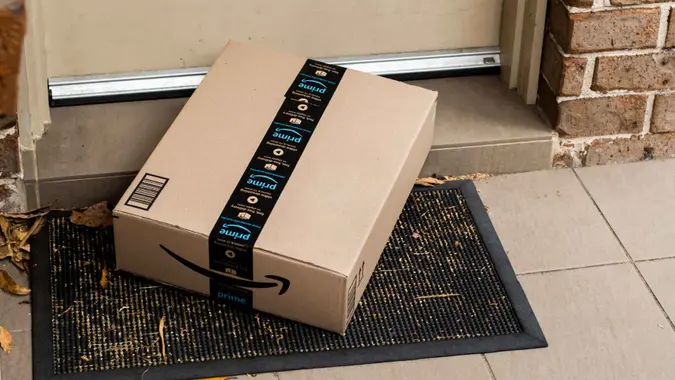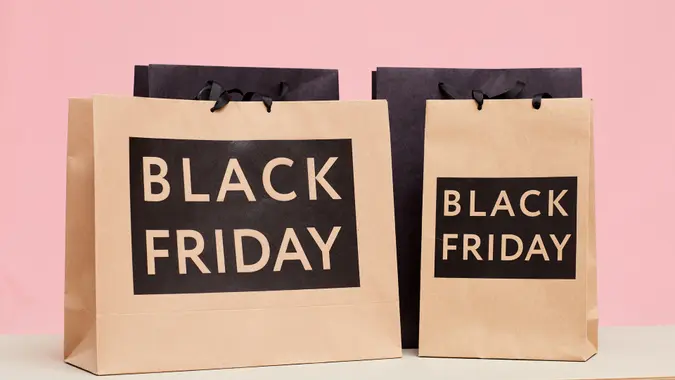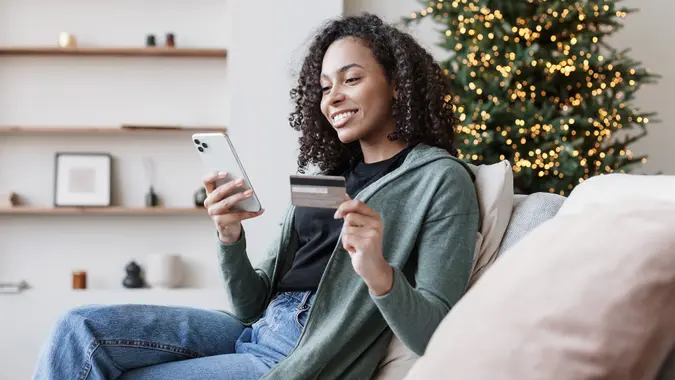How to Stop Impulse Buying

Commitment to Our Readers
GOBankingRates' editorial team is committed to bringing you unbiased reviews and information. We use data-driven methodologies to evaluate financial products and services - our reviews and ratings are not influenced by advertisers. You can read more about our editorial guidelines and our products and services review methodology.

20 Years
Helping You Live Richer

Reviewed
by Experts

Trusted by
Millions of Readers
We all occasionally purchase something without a lot of thought, but a consistent pattern of impulse buying can put you at risk for financial strain, impacting your ability to save and potentially even causing or increasing debt.
Why Do We Impulse Buy?
Understanding why we make impulse purchases can be key to changing the habit. Ultimately, there are multiple reasons why we end up swiping our card for impulse purchases, including:
- Loss aversion: Some people may feel that if they don’t purchase the item, they’ll miss out and may not be able to get it later. Fear of missing out (FOMO) is a type of loss aversion.
- The shopping dopamine rush: Shopping is fun, and purchasing something can actually release dopamine, which is a “feel good” hormone. This can contribute to habitual impulse shopping, as people may continue to seek additional dopamine.
- Sales and marketing tactics: Talented sales and marketing campaigns can convince us we need to make a purchase and we need to make it now.
- Habit: How we spend money is largely habitual, so if we’re used to splurging on a treat without a lot of thought, it doesn’t feel like an impulse.
- Lack of tracking spending: It’s easy to wrack up an impressive credit card bill if we’re failing to track all the small impulse purchases, and if you don’t know what’s already been spent it can be easy to spend just a bit more.
- Desire to save: Sales and discounts can cause people to make impulse purchases on items they wouldn’t spend out of a desire to save. This can tie in with loss aversion and not wanting to miss a great deal.
- Comparing: It’s easy to compare ourselves to others, which can sometimes drive impulse purchases so we don’t “miss out” or to “keep up” with other people.
12 Tips to Stop Impulse Buying
If you want to reduce impulse purchases (or even stop them altogether!), here are 12 practical tips that can help.
1. Understand What’s Driving You to Purchase
Then find a way to address that particular issue.
If something is driving you to unconsciously seek a dopamine rush, for example, you may want to consider choosing a hobby that can provide that same feeling. Or, if you feel like you’re saving money shopping sales, you might want to track your spending to see if that’s actually the case.
2. Make a List When Shopping
If you’re trying to cut back on impulse purchases, make a list before you go shopping and know that you’ll only buy what’s on the list.
3. Avoid Clicking on Marketing Materials
All the ads and emails we see on a daily basis are designed to capture our interest, get us to click and purchase.
If you see an email promising a sale in your inbox, delete it without opening it. Chances are good if you click, you’ll see a product tailored to your interests that will feel like too good of a deal to miss out on.
4. Don’t Compare
Comparing yourself to friends, neighbors, coworkers and especially influencers on social media can be a quick way to ramp up impulse purchasing. You can quickly spend more to “keep up” without realizing it.
You can unfollow social media accounts that motivate you to purchase.
5. Change Your Credit Card Usage
Credit cards can feel like free money, but they can lead to really expensive debt. You can limit spending on credit cards by:
- Only charge what you can pay off today: If you don’t have money in your account so that you could pay off that charge as soon as you get home, don’t make the purchase.
- Set up alerts on your phone: Sometimes receiving mobile alerts when you make purchases on your credit card can help you track the balance, which may reduce continual impulse spending in a single shopping spree.
- Have spending limits for credit: Maybe you’re comfortable having a $20 impulse spending limit for your credit card; anything else needs to come from the $100 in cash you have in your purse.
6. Set Financial Goals
Over time, you can actually replace some of that dopamine rush for shopping with a dopamine rush for saving.
Set clear financial goals. This may include having $5,000 in an emergency fund, a down payment for a house or six months of living expenses saved in cash. When you have clear goals, it can be easier to resist impulse purchases.
Some people may even do a no-spend challenge until they reach certain goals, where they only purchase essentials that they need.
7. Distinguish Between Wants and Needs
Do you really need a new dress for your friend’s baby shower? If you don’t have any that fit, then yes you need it, but if you just want a new dress for the pictures, it’s a want and not a need.
Some people find it helpful to make a physical list of what they need and what they want. You can prioritize a few things on the “want” list if you have the budget for it, but proactively saying “I want but don’t need more plants for the backyard” can help you resist impulse purchases when you see them in-person.
8. Only Carry Cash
While credit cards and debit cards are popular, they also allow you to walk around with thousands (if not tens of thousands) of spending power.
If your rule is that you can only make impulse purchases with the cash you have on hand– especially on shopping days– it can help force you to stick to a budget.
9. Stick to Your Budget
Start by determining how much money you need to pay essential costs like rent, utilities, car payments and groceries. Then, consider any savings goals you have, like saving for retirement or a new car. Once you do that, you can determine how much you have left over for “fun” or even “impulse” purchases.
Here’s some common budgeting methods to get you started.
10. Stick to The 1% Rule
The 1% rule requires you to wait a day before purchasing an item that is more than 1% of your annual gross income.
For example, if you make $70,000 a year before taxes are taken out, this means you need to wait before making an impulse buy of $700 or more. This tip is best for people who make more substantial impulse purchases.
11. Don’t Fall For The Sale Trap
A recent study from Capital One found that 70% of all consumers have impulsively made a purchase exclusively because it was on sale.
A good rule for sales: If you’ve already been wanting to purchase the item for awhile, you’re good to get it on sale. And if you wouldn’t buy it when it’s not on sale, think twice about purchasing it just because there’s a discounted price.
12. Put The Money Into Savings Instead
Sometimes it can be difficult to understand exactly how all the impulse purchases are adding up until you see it in concrete numbers. And when I bought my first house, I know that it was tempting to purchase what I needed to furnish and decorate it the way I wanted.
To avoid making impulse purchases, I’d move the money I would have spent on the item into a high yield savings account instead. Even the occasional $10 lunch I decided to have at home added up to a significant amount over time.
By putting even small balances into savings, you can effectively see the impact of how all impulse purchases are impacting your savings overtime. Replacing the act of buying with the act of saving can help shift the habit.
Reducing Impulse Spending
Impulse purchases impact most of us in some way. While grabbing the occasional treat when we’re out and about likely won’t derail your budget, however, it’s important to remember that even small purchases can add up quickly. Monitor your impulse spending to make sure it’s not impacting your progress towards financial goals or even potentially putting you at risk for debt.
If you’re struggling to get a handle on impulse spending, it may be helpful to speak with a therapist about behavior modification options.
You can also work with a financial advisor to develop a budget that will help you stay on track for long-term financial goals, like buying a house or saving for retirement.
FAQ
Impulse buying impacts many of us in one way or another. Here are some commonly asked questions and answers that may help provide additional clairty on the topic.- What is the 1% rule for impulse buys?
- The 1% rule for impulse buys says that if a purchase is more than 1% of your annual gross income, you should wait at least a day before buying it.
- What is the root cause of impulse buying?
- There may be several root causes of impulse buying, including familial habits, craving dopamine, loss aversion, or feeling like you’re getting a good deal with a sale. It’s important that each person considers what motivates them to make impulse purchases if they want to change this habit.
- What is impulse buying a symptom of?
- In some cases, impulse buying could be a symptom of mental health conditions like depression or anxiety, especially if buyers feel they need to make a purchase to be happy or to protect against loss aversion.
- How to resist the urge to buy stuff?
- The first step in resisting the urge to make impulse purchases is to understand any triggers causing you to make them. Do you feel pressure to take advantage of a great sale, or are you living for the dopamine rush of having a package delivered to the door?
Our in-house research team and on-site financial experts work together to create content that’s accurate, impartial, and up to date. We fact-check every single statistic, quote and fact using trusted primary resources to make sure the information we provide is correct. You can learn more about GOBankingRates’ processes and standards in our editorial policy.
- Capital One. "Discount Marketing Statistics"
- Harvard Health "Dopamine: The pathway to pleasure"
- American College of Health Care Administrators "The Psychology of Impulse Buying"
- ScienceDirect "Relationship between compulsive buying and depressive symptoms among males and females"
 Written by
Written by  Edited by
Edited by 
























